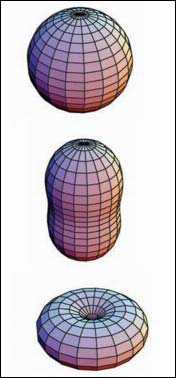Zooming in on a proton packed with surprises

The shape of the proton can differ, depending on the angular momentum of quarks. <br>(Gerald A. Miller/University of Washington)
The structure of the proton is under the microscope at the U.S. Department of Energy’s Thomas Jefferson National Accelerator Facility (Jefferson Lab) in Newport News, Virginia, where a series of experiments continues to produce unexpected results.
Simple theories of proton structure say that the way electric charge is distributed in the proton is the same as the magnetization distribution. But Jefferson Lab results indicate these distributions are definitely different.
A fundamental goal of nuclear physics is to understand the structure and behavior of strongly interacting matter in terms of its building blocks, quarks and gluons. An important step toward this goal is a description of the internal structure for the proton and neutron, collectively known as nucleons. Jefferson Lab was built, in part, to study the physics of quarks and gluons and their connection to larger composite objects like protons.
The proton is the positively charged core of the hydrogen atom, the most abundant element in the universe. It is made up of three charged quarks and the gluons that bind them together. The quarks move around, so the proton has a charge distributed over its size. This leads to the generation of an electric current, which in turn induces a magnetic field. In addition, quarks and gluons both have spin, leading to a magnetic moment. The combination of the total magnetic field and the magnetic moment is a quantity called magnetization.
Jefferson Lab is uniquely positioned to measure the proton’s electric charge and magnetization distributions, the so-called electromagnetic form factors that describe its internal structure.
In two recent Jefferson Lab experiments, researchers directed the accelerator’s polarized electron beam toward liquid hydrogen cooled to 17 Kelvin (–429°F). Each electron in the beam has an intrinsic angular momentum, or spin. The beam of electrons is said to be “polarized” if their spins point — on average — in a specific direction. As an electron collided with a proton in the hydrogen target, the proton recoiled, becoming polarized during the interaction. The scattered electron and recoiling proton were then detected in two high-resolution spectrometers (HRS), and the proton polarization was measured by a specially developed detector called a proton polarimeter.
From these measurements, the researchers could obtain a ratio of electric charge distribution to magnetization distribution — the electric and magnetic form factors — at various depths inside the proton. Their experiments revealed unexpected and significantly different energy-dependence for the form factors. The data showed that the proton’s charge distribution is not the same as its magnetization distribution; the charge distribution is more spread out than the magnetization.
These results are very interesting to both experimental and theoretical physicists. The Jefferson Lab data has already had an impact on theoretical models, helping rule out some models, directing others toward a better description of internal proton structure.
One such model was developed in 1996 by physicists Gerald A. Miller and Michael R. Frank, both from the University of Washington in Seattle, and Byron K. Jennings from TRIUMF in Vancouver. The researchers predicted a fall-off in the ratio of the electromagnetic form factors but, at the time, they didn’t realize that experimental confirmation was possible. When the results of the first Jefferson Lab experiments probing proton structure were announced in 2000, the prediction was confirmed.
An interesting by-product of Miller’s theory is that the proton is not necessarily spherical in shape. Depending on the angular momentum of the quarks, the proton could be spherical in shape or more like a doughnut, a pretzel or a peanut. Miller says the variety of shapes is nearly limitless, and depends on the momentum of the quarks and the angle between the spin of the quark and the spin of the proton.
Media contact: Linda Ware, Jefferson Lab Public Affairs Manager, 757-268-7689, ware@jlab.org
Technical contacts: Vina Punjabi (punjabi@jlab.org); Charles Perdrisat (perdrisa@jlab.org)
Media Contact
All latest news from the category: Physics and Astronomy
This area deals with the fundamental laws and building blocks of nature and how they interact, the properties and the behavior of matter, and research into space and time and their structures.
innovations-report provides in-depth reports and articles on subjects such as astrophysics, laser technologies, nuclear, quantum, particle and solid-state physics, nanotechnologies, planetary research and findings (Mars, Venus) and developments related to the Hubble Telescope.
Newest articles

First-of-its-kind study uses remote sensing to monitor plastic debris in rivers and lakes
Remote sensing creates a cost-effective solution to monitoring plastic pollution. A first-of-its-kind study from researchers at the University of Minnesota Twin Cities shows how remote sensing can help monitor and…

Laser-based artificial neuron mimics nerve cell functions at lightning speed
With a processing speed a billion times faster than nature, chip-based laser neuron could help advance AI tasks such as pattern recognition and sequence prediction. Researchers have developed a laser-based…

Optimising the processing of plastic waste
Just one look in the yellow bin reveals a colourful jumble of different types of plastic. However, the purer and more uniform plastic waste is, the easier it is to…


